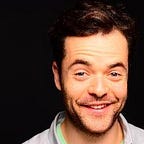“Community is like a muscle that grows when you practice together”
Whenever we start working with a new group, we usually introduce the practice of a “check-in” at the beginning of each call and a “check-out” at the end of each call. They are simple opportunities for people to share how they are showing up and how they are leaving the call. It humanizes the group and strengthens the relational web. At the beginning this feels awkward. Bringing an element of the personal into the professional still feels like a transgression, especially within larger organizations. But then, as we continue to do that repeatedly at each call, it becomes easier and easier. So much so, that after a while people expect it and even start doing it themselves, even when we’re not present.
You could call this a new habit, a ritual, a collective norm or a repetitive behavior. Ever since I heard Ants Cabraal share the following quote, I like to think of it as a muscle:
“Community is like a muscle that grows when you practice together” — Ants Cabraal
A powerful metaphor
I find the muscle metaphor insightful, because it reminds me that community is a living being, not a machine. If we practice regularly, the muscle will become stronger and if we don’t practice, it will start to fade. And in the context of community, the muscle metaphor becomes collective: through repeat practice, I can not only strengthen my own habit, but the collective behavior, too. And similar to muscle memory, we build a collective capacity to remember and to know without explicit guidance.
Examples of “community muscles”
A group of cyclists message each other at 6am every morning in the Whatsapp to check who is joining for today’s ride. It’s a daily ritual. Or: At the gathering it seems normal that everyone hugs each other and people say to each other: “I appreciate you”. Or: In our community, organizing a potluck is simple, everyone knows how the format works and how we can contribute.
There are certainly plenty of community moments when the collective muscle hasn’t developed yet. For example: At the gathering tension arises and nobody knows how to deal with it. What should we do? Or: so far being part of the community was always free, so asking members to contribute feels strange.
A community muscle shows up in:
- A rhythm that feels natural. For example: we always meet on the first Tuesday of the month.
- Rituals that happen regularly. For example: we light a candle at the beginning of our gatherings.
- Key formats. There are a few gathering formats that we continuously organize and people know how to organize them well.
- Distributed knowledge: it’s not only a few people at the top who know how to do things. Many people know how to do things. This knowledge spreads by peers watching peers.
- Embodied values: we have internalized that in this group we treat each other in certain ways. For example: In this group it’s normal, even encouraged, that we challenge each other’s opinions.
- Co-creation: It’s natural in this group that things are created together. Nobody waits for top-down leadership.
- Comfort with hard things: we have capacity to deal with conflict, tensions, disagreement.
Community muscle -> distributed leadership?
Many of us are trying to weave communities and networks that don’t depend on central leadership. While leadership is still crucial, we understand that in order for the community to thrive and be sustainable, we have to decentralize how we organize and co-create. But how do things not only get done in a decentralized way, but stay coherent and integrated as a whole? I don’t know the answer to that question, but my hunch is that strengthening the collective muscle is actually closely related to building our capacity for distributed leadership.
What do you think??
I’d be curious and grateful to hear how this community as a collective muscle resonates with you. Thank you for sharing your thoughts.
—
Thank you
Thank you Ants Cabraal for sharing this beautiful quote. Thank you to my collaborators who have deepened my understanding of community as a muscle: Michel Bachmann, Erin Dixon, Sita Magnusson, Lana Jelenjev, Nettra Pan.
Interested in getting regular community building insights in your inbox?
Every few weeks we send out a short email with 3–5 of our favorite insights, blog posts and articles about building meaningful communities. If you care about bringing people together, this might be for you. Sign up here.
